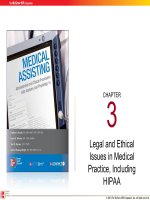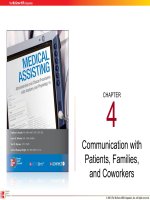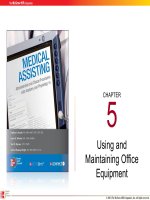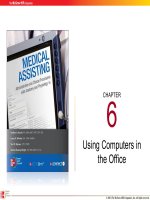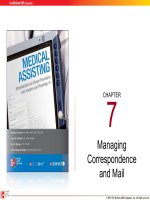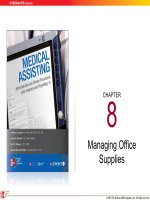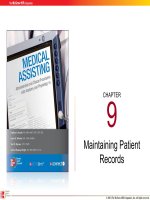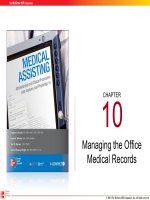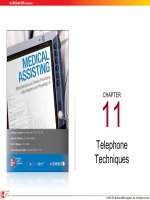Lecture Medical assisting: Administrative and clinical procedures with anatomy and physiology (4/e) – Chapter 47
Bạn đang xem bản rút gọn của tài liệu. Xem và tải ngay bản đầy đủ của tài liệu tại đây (906.29 KB, 51 trang )
CHAPTER
47
Collecting,
Processing, and
Testing Urine
Specimens
© 2011 The McGraw-Hill Companies, Inc. All rights reserved.
472
Learning Outcomes
47.1 Describe the characteristics of urine, including
its formation, physical composition, and
chemical properties.
47.2 Explain how to instruct patients in specimen
collection.
47.3 Identify guidelines to follow when collecting
urine specimens.
47.4 Describe proper procedures for collecting
various urine specimens.
© 2011 The McGraw-Hill Companies, Inc. All rights reserved.
473
Learning Outcomes (cont.)
47.5 Explain the process of urinary catheterization.
47.6 List special considerations that may require
you to alter guidelines when collecting urine
specimens.
47.7 Explain how to maintain the chain of custody
when processing urine specimens.
47.8 Explain how to preserve and store urine
specimens.
© 2011 The McGraw-Hill Companies, Inc. All rights reserved.
474
Learning Outcomes (cont.)
47.9 Describe the process of urinalysis and its
purpose.
47.10Identify the physical characteristics present
in normal urine specimens.
47.11Identify the chemicals that may be found in
urine specimens.
47.12Identify the elements categorized and
counted as a result of microscopic
examination of urine specimens.
© 2011 The McGraw-Hill Companies, Inc. All rights reserved.
475
Introduction
• Routine analysis of a urine specimen
– Noninvasive
– Used to diagnose significant conditions
• Medical assistant
– Learn about types of urine specimens
– Instruct or assist patient in collection of a
sample
– Learn to process urine specimens
– Learn about normal/abnormal components of
urine
© 2011 The McGraw-Hill Companies, Inc. All rights reserved.
476
Role of the Medical Assistant
• Collect, process, and
test urine samples
• Knowledge necessary
– Anatomy and
physiology of kidneys
– How urine is formed
– Normal components of
urine
© 2011 The McGraw-Hill Companies, Inc. All rights reserved.
477
Role of the Medical Assistant
• Safety
– Standard Precautions
– PPE as needed
– Handle and dispose of
specimens properly
– Dispose of used supplies
and equipment properly
– Sanitize, disinfect,
and/or sterilize reusable
equipment
© 2011 The McGraw-Hill Companies, Inc. All rights reserved.
478
Anatomy and Physiology of the Urinary System
• Organs
– Kidneys – remove excess
water and waste products
– Ureters – drain urine into
bladder
– Bladder – stores urine
– Urethra – drains urine to
outside of the body
© 2011 The McGraw-Hill Companies, Inc. All rights reserved.
479
Formation of Urine
• Nephron
– Functional unit of the
kidney
– Removes end
products of
metabolism
– Allows for
reabsorption of water
and electrolytes
• Processes in urine
formation
– Glomerular filtration
– Tubular
reabsorption
– Tubular secretion
– Maintains normal fluid
balance
© 2011 The McGraw-Hill Companies, Inc. All rights reserved.
4710
Physical Composition and Chemical Properties
of Urine
• 95% water
• 5% waste products
• Other dissolved
chemicals
–
–
–
–
–
Urea
Uric acid
Ammonia
Calcium
Creatinine
–
–
–
–
–
Sodium
Chloride
Potassium
Sulfates
Phosphates
Hydrogen ions
Urochrome
Urobilinogen
A few RBCs
A few WBCs
© 2011 The McGraw-Hill Companies, Inc. All rights reserved.
4711
Apply Your Knowledge
1. What knowledge is needed by the medical assistant
related to collecting, processing, and testing urine
specimens?
ANSWER: The medical assistant needs to know the anatomy and
physiology of the urinary system, how urine is formed, and normal
components of urine.
2. Components of normal urine include
A. urea, uric acid, and ammonia.
B. chloride, potassium, and sugar.
C. red blood cells, sperm, and H2O2
D. hydrogen ions, urochrome, and
uranium.
ANSWER:
© 2011 The McGraw-Hill Companies, Inc. All rights reserved.
4712
Obtaining Specimens
• General collection guidelines
– Follow the procedure for specified test
– Use an appropriate specimen container
– Label the specimen container correctly
– Explain the procedure to patient
– Wash your hands before and after the
procedure; wear gloves during the procedure
– Complete all necessary paperwork
© 2011 The McGraw-Hill Companies, Inc. All rights reserved.
4713
Specimen Types
• Quantitative analysis – measures
amount of a specific substance
in the urine
• Qualitative analysis – simply
determines if a substance is
present in the urine
• Types vary in the method used to collect a
specimen and in the time frame in which to
collect a specimen
© 2011 The McGraw-Hill Companies, Inc. All rights reserved.
4714
Specimen Types (cont.)
• Random urine
specimen
– Most common
– Obtained any time
during the day
• First morning
specimen
– Contains greater
concentration of
substances
• Clean-catch
midstream
– Used for culturing
urine
– External genitalia must
be cleansed
– Discard small amount
of urine prior to
collecting specimen
– Can also obtain by
catheterization
© 2011 The McGraw-Hill Companies, Inc. All rights reserved.
4715
Specimen Types (cont.)
• Timed urine specimen
– Discard first specimen
– Collect all urine for specified time
– Refrigerate
• 24-hour specimen
– Collected as a timed specimen
• Both are used for qualitative and
quantitative analysis
© 2011 The McGraw-Hill Companies, Inc. All rights reserved.
4716
Catheterization
• Urinary catheter – a
plastic tube inserted
to provide urinary
drainage
• Catheterization –
procedure by which
the catheter is
inserted
© 2011 The McGraw-Hill Companies, Inc. All rights reserved.
4717
Catheterization (cont.)
• Reasons for catheterization
– Relieve urinary retention
– Obtain a sterile urine specimen
– Measure the amount of residual urine
– Obtain a specimen if patient cannot
void
– Instill chemotherapy
– Empty bladder before and during
procedures
© 2011 The McGraw-Hill Companies, Inc. All rights reserved.
4718
Catheterization (cont.)
• Drainage catheters
– Indwelling urethral (Foley) catheter – bladder
– Retention catheter – renal pelvis
– Ureteral catheter – drainage through a wound
into the bladder (cystostomy tube)
– Straight catheter – bladder
• Splinting catheter – inserted after repair
of ureter
© 2011 The McGraw-Hill Companies, Inc. All rights reserved.
4719
Catheterization (cont.)
• Not a routine procedure due to risk of
infection
• Not typically performed
by medical assistants
– Check scope of practice
– Assemble supplies –
catheterization kits
© 2011 The McGraw-Hill Companies, Inc. All rights reserved.
4720
Special Considerations
• Male and female patients
– Differences in collecting
clean-catch midstream specimen
– Questions during history
• Pregnant patients
– Frequency
– Prone to urinary tract infection
– Urine checked for glucose and protein
© 2011 The McGraw-Hill Companies, Inc. All rights reserved.
4721
Special Considerations (cont.)
• Elderly
– Bladder muscles
weaken
– Uterine supports
weaken – pulls on
bladder
– Loss of bladder control
– May need assistance
in obtaining a
specimen
– Repeat explanation as
necessary
• Pediatric patients
– Involve child if
possible
– Questions
•
•
•
•
•
Diaper rash?
Excessively thirsty?
Difficulty urinating?
Cry when urinating?
How many diapers a
day?
• Change in bladder
control?
• Problems toilet
training?
© 2011 The McGraw-Hill Companies, Inc. All rights reserved.
4722
Establishing Chain of Custody
• Do not alter
• Examine specimen
established procedure
and check
temperature
• Positively identify
patient
• Complete
• Explain procedure
documentation
and have patient sign
a consent form
© 2011 The McGraw-Hill Companies, Inc. All rights reserved.
4723
Preservation and Storage
• Chemical, physical, and microscopic changes
occur if urine is left at room temperature for
more than 1 hour
• Preservation
– Refrigeration
Specimens
only
• Prevents growth for 24 hours
• Return to room temperature before testing
– Chemical preservatives
© 2011 The McGraw-Hill Companies, Inc. All rights reserved.
4724
Apply Your Knowledge
A patient has returned to the office and is complaining of
not being able to empty her bladder fully after her
hysterectomy. The physician has asked you measure
the patient’s residual urine. How do you do this and why?
ANSWER: A residual urine is done to measure the amount of urine in
the bladder after voiding. You will ask the patient to empty her
bladder and then perform a straight catheterization to measure any
urine remaining in her bladder.
Correct!
© 2011 The McGraw-Hill Companies, Inc. All rights reserved.
4725
Urinalysis
• Evaluation of urine to obtain information
about body health and disease
• Types of testing
– Physical
– Chemical
– Microscopic
© 2011 The McGraw-Hill Companies, Inc. All rights reserved.

